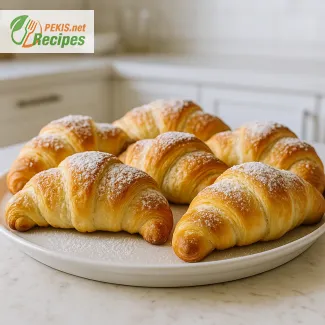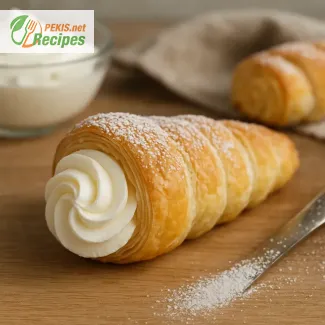
Baking a traditional Christmas loaf is an experience that captures the essence of the holiday season, blending time-honored recipes with the warmth of a home filled with the scent of freshly baked bread. This delicious loaf is more than just a treat—it's a celebration of family traditions, comforting flavors, and the spirit of togetherness. Whether you are a seasoned baker or a beginner, this recipe will guide you through creating a perfectly golden and fluffy Christmas loaf that will make your festive gatherings even more memorable.
At the heart of every Christmas loaf is a rich combination of aromatic spices, sweet fruits, and nuts that create a uniquely festive flavor profile. Ingredients like cinnamon, nutmeg, and cloves infuse the dough with an unmistakable warmth, while raisins, sultanas, or currants offer a delightful burst of sweetness. The addition of candied peel or mixed dried fruits brings a touch of festive luxury, making every bite a moment to savor.
This recipe combines the art of baking with the joy of preparing something truly special for the holiday season. The dough is rich and buttery, yet light enough to allow the flavors of the fruits and spices to shine through. What makes this loaf particularly irresistible is its perfect texture: soft, tender, and slightly sweet with a crusty golden finish that offers the ideal contrast to the pillowy interior. It is a wonderful accompaniment to afternoon tea, or served as a luxurious breakfast or snack for guests during the festive season.
When baking this traditional Christmas loaf, the key to success lies in the dough’s rise and the slow, careful baking process. Allowing the dough ample time to prove ensures the loaf will have an airy, tender crumb, while the slow baking process ensures the exterior develops a deep golden color and slight crispiness. As the loaf bakes, the spicy-sweet fragrance will fill your home, evoking cherished memories of past holiday celebrations and creating a new tradition in your own kitchen.
What makes this Christmas loaf even more delightful is its versatility. You can customize the ingredients to suit your preferences, whether by adding your favorite nuts, substituting fruits, or experimenting with different spices. The richness of the dough also makes it a fantastic base for toppings, such as a dusting of powdered sugar or a drizzle of glaze, making it look as festive as it tastes.
Baking this loaf isn't just about creating a delicious dish; it's about sharing a piece of holiday spirit. It's the perfect homemade gift for loved ones or a standout centerpiece for your Christmas spread. The beauty of a homemade loaf lies in its imperfections—the slight cracks on top, the uneven glaze, the character of a homemade product that store-bought breads can never match.
Nutritionally, this Christmas loaf offers a combination of rich flavors and wholesome ingredients. The inclusion of dried fruits provides natural sweetness, and the nuts give the loaf a satisfying texture and a touch of healthy fats. The spices not only elevate the flavor but also have antioxidant properties, making this loaf a treat that delights both your taste buds and your health. Whether enjoyed with a cup of hot cocoa or as part of a festive brunch, this Christmas loaf is sure to become a staple in your holiday celebrations for years to come.
So, if you're looking for a way to bring a little extra magic to your Christmas table, learning how to bake a traditional Christmas loaf is a fantastic choice. This recipe combines all the flavors and textures that make Christmas so special, and when shared with family and friends, it becomes much more than just a loaf of bread—it becomes a symbol of the love and joy that the holiday season brings. Prepare it with care, and it will surely become a cherished part of your Christmas tradition.
- Activate the yeast: In a small bowl, dissolve the fresh yeast and sugar in the warm milk. Let it sit for 5-10 minutes until it becomes frothy, indicating that the yeast is active.
- Prepare the dough: In a large mixing bowl, combine the flour, cinnamon, nutmeg, cloves, and salt. Make a well in the center and add the activated yeast mixture, egg, and softened butter. Mix everything together until it forms a sticky dough.
- Knead the dough: Turn the dough onto a lightly floured surface and knead for 8-10 minutes, or until it becomes smooth and elastic. Add a little more flour if necessary, but try to keep the dough as moist as possible for a soft loaf.
- Incorporate the fruits and nuts: Flatten the dough slightly and sprinkle the dried fruits, candied peel, and nuts (if using) evenly over it. Fold the dough over the ingredients and knead gently to incorporate them.
- First rise: Place the dough into a greased bowl, cover it with a clean kitchen towel, and let it rise in a warm place for about 1 hour, or until it has doubled in size.
- Shape the loaf: After the dough has risen, gently punch it down to release the air. Shape the dough into a loaf by rolling it into a tight log. Place it into a greased loaf tin (approx. 25 x 12 cm or 9 x 5 inches).
- Second rise: Cover the loaf tin with a towel and allow the dough to rise for another 30 minutes to 1 hour, until it has puffed up.
- Preheat the oven: Preheat the oven to 180°C (350°F / Gas Mark 4).
- Bake: Bake the loaf for 30-35 minutes, or until the top is golden brown and the loaf sounds hollow when tapped on the bottom. If the loaf is browning too quickly, cover it loosely with foil and continue baking.
- Cool and serve: Allow the loaf to cool in the tin for 10 minutes, then transfer it to a wire rack to cool completely. Slice and serve.
How to Enhance Your Traditional Christmas Loaf: Expert Tips for Perfecting the Recipe
Baking a traditional Christmas loaf is a wonderful way to celebrate the holiday season. This rich, spiced bread, filled with dried fruits and nuts, is more than just a treat—it's a symbol of the warmth and joy of Christmas. While the basic recipe for a traditional Christmas loaf is tried and true, there are many ways to elevate the flavor, improve the texture, and customize the loaf to suit your personal preferences. Below are several professional tips for enhancing your Christmas loaf, ensuring it turns out perfectly moist, fluffy, and full of festive flavor.
1. Choose the Right Flour for Texture and Rise
The foundation of any good loaf is the flour, and using the right type of flour can make all the difference in the texture and rise of your Christmas loaf. For a light and fluffy loaf, use strong white bread flour (also known as high-gluten flour). This type of flour has a higher protein content, which provides more structure to the dough and helps it rise beautifully. If you prefer a slightly denser loaf with more chew, you can mix bread flour with a small portion of whole wheat flour. This will add depth of flavor and a slightly richer texture.
For a gluten-free option, you can use a high-quality gluten-free flour blend. Be sure the blend contains xanthan gum or guar gum to help the loaf rise and maintain its structure. Keep in mind that gluten-free doughs often require a bit more hydration, so adjust the liquid content as needed.
2. The Importance of Yeast Activation
One of the most critical steps in making a fluffy Christmas loaf is properly activating the yeast. Active yeast is what makes the dough rise and become light and airy. Always check the expiration date on your yeast packet and store it in a cool, dry place to ensure it remains effective. If using fresh yeast, crumble it directly into the warm milk (not hot, but lukewarm, around 37°C or 98.6°F). Sugar helps to activate the yeast, so be sure to add it to the milk along with the yeast.
Let the yeast mixture sit for 5 to 10 minutes until it becomes frothy and bubbly. This is a sign that the yeast is alive and ready to do its job. If your mixture doesn't foam, discard it and try again with fresh yeast.
If you prefer a sourdough-style Christmas loaf, consider using a sourdough starter instead of commercial yeast. This adds complexity to the flavor, creating a tangy and slightly chewy texture that contrasts wonderfully with the sweetness of the dried fruits.
3. Butter: A Richness Factor
Butter plays an essential role in giving your Christmas loaf its rich, tender crumb. Always use unsalted butter in baking to have better control over the salt content. If you want to achieve a slightly richer, richer flavor, use European-style butter which has a higher fat content, making the loaf extra moist and decadent.
For those seeking a dairy-free option, swap the butter with a high-quality dairy-free margarine or coconut oil. Both provide the necessary moisture and tenderness. However, using coconut oil will impart a subtle coconut flavor to the loaf, which can be a lovely twist for those who enjoy tropical flavors.
4. Flavor Enhancements: Spices and Extracts
The spices in a traditional Christmas loaf are what give it that characteristic holiday aroma. However, the type and quality of the spices you use can greatly affect the flavor profile. Freshly ground spices such as cinnamon, nutmeg, and cloves provide more intense, vibrant flavors than pre-ground varieties. Invest in whole spices and grind them yourself for the best possible results.
If you want to boost the flavor even further, consider adding a teaspoon of vanilla extract or almond extract. These extracts enhance the sweet, warm notes of the dried fruits and the spiced base. For those who love a little zest, add finely grated orange peel or lemon zest to the dough. The citrus notes will complement the dried fruits and add a refreshing burst of flavor.
5. Choosing and Preparing Dried Fruits
The combination of dried fruits is one of the hallmarks of a traditional Christmas loaf. Raisins, currants, sultanas, and dried cranberries are common choices, but feel free to experiment with other dried fruits such as apricots, dates, or figs.
To ensure the dried fruits don’t sink to the bottom of the loaf during baking, coat them in flour before adding them to the dough. This helps to evenly distribute them throughout the loaf. Also, soak your dried fruits in warm fruit juice (like orange juice) or rum for about 30 minutes before mixing them into the dough. This not only plumps up the fruits, making them softer and juicier, but it also infuses the dough with additional flavor.
For an even more luxurious loaf, consider adding candied peel or crystallized ginger. These ingredients contribute a delightful sweetness and a slightly chewy texture, providing a contrast to the crunchy nuts.
6. Incorporating Nuts and Seeds
While not traditionally a part of all Christmas loaf recipes, adding chopped nuts can bring both texture and flavor. Walnuts, pecans, and hazelnuts are popular choices, as they complement the sweetness of the fruit and spices. You can also experiment with toasting the nuts before adding them to the dough. This will release their essential oils, enhancing the nutty aroma and flavor in the finished loaf.
If you're adding seeds, such as sunflower seeds or pumpkin seeds, these add a delightful crunch to the loaf’s texture, making each bite more satisfying.
7. Kneading and Proofing: Technique Matters
Proper kneading is crucial for developing the gluten in the dough, which helps give the loaf structure. Knead the dough for at least 8-10 minutes, until it becomes smooth and elastic. If the dough feels too sticky, sprinkle a little flour, but don’t overdo it—excess flour can make the loaf dense and dry.
Once kneaded, let the dough rise for about 1 hour in a warm place, or until it doubles in size. This is the first proofing. Cover the dough with a damp kitchen towel or plastic wrap to prevent it from drying out. If you're baking on a cold day, you can place the dough in an oven with the light on to create a warm environment, or use a proofing box.
After the first rise, punch down the dough to release the air and reshape it into a loaf. Allow it to rise again for 30-45 minutes, or until it has puffed up and reached the top of the loaf tin.
8. Baking: Perfect Timing and Temperature
Baking a Christmas loaf requires careful attention to time and temperature. Preheat the oven to 180°C (350°F) before placing the loaf inside. Bake it for 30-35 minutes, or until the top is a deep golden brown and the loaf sounds hollow when tapped on the bottom. If you’re concerned that the loaf might burn on top before cooking through, tent the loaf with foil during the last 10-15 minutes of baking.
For an extra glossy finish, brush the loaf with a little butter or milk just before baking. This will give it a beautifully shiny crust. Once baked, allow the loaf to cool completely on a wire rack before slicing.
9. Storage and Serving Suggestions
Once baked, allow your Christmas loaf to cool completely. Slice it with a serrated knife to ensure clean, even slices. If you’re not consuming the loaf right away, store it in an airtight container at room temperature for up to 4-5 days. Alternatively, you can freeze slices of the loaf for up to 3 months, allowing them to thaw at room temperature before serving.
To serve, this Christmas loaf is delicious on its own or with a spread of butter, cream cheese, or jam. It pairs wonderfully with a hot cup of tea or mulled wine during the holiday season.
Creating a Personalized Christmas Loaf
By incorporating these professional tips, you can elevate your traditional Christmas loaf to a new level. Whether it’s choosing the best flour, experimenting with spices, or enhancing the texture with dried fruits and nuts, these thoughtful adjustments will ensure your loaf is a festive showstopper. Remember, the beauty of baking is in the personal touch, so don’t hesitate to make the recipe your own. The result will be a loaf that is not only a treat for the taste buds but also a joy to share with loved ones during the holiday season.
This recipe contains gluten, dairy (butter), eggs, and nuts (optional). For those with gluten intolerance, you can substitute the flour with a gluten-free flour blend (ensure it contains xanthan gum or another binder). For a dairy-free option, replace the butter with a non-dairy spread, and use a plant-based milk (such as almond or oat milk). To avoid nuts, simply omit them from the recipe.
- Vitamin A: 180 IU – Supports immune function and vision health.
- Vitamin C: 2 mg – Important for skin health and immune function.
- Iron: 1.4 mg – Vital for transporting oxygen in the blood and preventing anemia.
- Calcium: 20 mg – Important for strong bones and teeth.
- Magnesium: 20 mg – Supports muscle function and nerve transmission.
- Cinnamon contains polyphenols which have anti-inflammatory properties.
- Cloves are rich in eugenol, an antioxidant that may support liver health.
- Raisins provide resveratrol, which has potential cardiovascular benefits.
Enjoy this traditional Christmas loaf as part of your holiday celebrations! The combination of warm spices, sweet fruits, and a soft, buttery texture makes it the perfect treat for sharing with loved ones.





